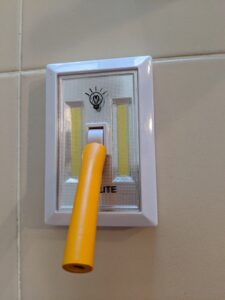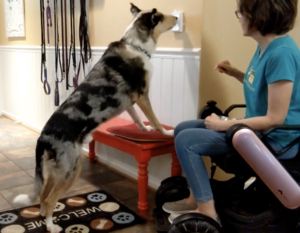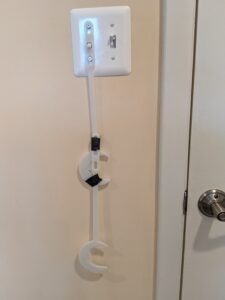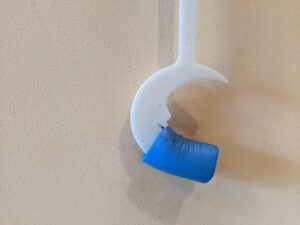Turning light switches on and off is a commonly needed service dog task for dogs helping people who have disabilities ranging from mobility impairments and low vision to PTSD. This is one of those service dog tasks that seems straightforward, but the particulars make it one that requires careful planning around the logistics of the training process, the reachability of the switch, and the dog’s ability to discriminate between the cues for turning the lights on and off.
Training Process
During the training process the dog will repeatedly be flipping the switch. Trainers new to service dog training often make the mistake of working with an actual light switch. This risks damaging the switch, and of course during the process the light will be switching on and off repeatedly. A better and safer bet is to begin with a battery-operated light switch. Remove the batteries during the training process, since many of these lights are very bright, and having a light shine directly in the dog’s face during training can startle and scare the dog. You can begin working with the light switch in your hand and then transfer or teach the targeting behavior, or you can use temporary adhesive to place the switch on the wall at a comfortable height for the dog.

Reaching the Switch
A significant logistical challenge is the height of most light switches (most are situated at 48 inches). Service dog programs have sometimes trained dogs to jump on the wall and hit the switch with either their nose or paw. However, not all dogs can reach a light switch if they jump up. Also, even if the dog can reach the switch by jumping, this approach presents several problems. From an aesthetic perspective, the dog may muddy or scratch the wall when jumping. More importantly, if the dog touches the switch with wet paws or a wet nose, they could potentially get a shock. During the training process the dog will need to perform the behavior repeatedly. This is physically taxing for the dog and could even potentially lead to an injury. Service dogs need to perform tasks over a period of years. As the service dog ages, physically difficult tasks like jumping on a wall will become harder or even impossible for the dog to do. By taking steps to make the task easier for the dog, you will enable the dog to help the owner by performing the task for a longer period of time.
There are several ways to help service dogs more easily perform this task. One approach is to have the dog step up on a stool, chair or other platform to reach the light switch. Make sure the surface of the stool or bench has a mat or other similar item to provide traction for the dog. In addition, adding some foam tubing to the switch itself can make it easier for the dog to operate – and less likely that the dog gets the switch wet. Even extending a switch a few inches can make a big difference.

In some homes it may not be practical to keep a stool under a light switch. People who use adaptive equipment like walkers or wheelchairs often need very wide areas to maneuver, and extra furniture can get in the way. A light switch extender is a terrific tool to address this challenge without the need for additional furniture. Light switch extenders are inexpensive plastic devices that are used to make a light switch easier for a child to reach. You can connect two extenders or more so the bottom of the extender is easy for the dog to reach. Adding foam tubing to make the bottom of the extender wider and easier to see, and can make it even easier for the dog to manipulate.
Putting the behavior on cue
Service dogs are often trained to turn lights on and off using very similar behaviors, for instance, turning the switch on may involve an upward movement of the dog’s nose and turning it off may involve a downward motion. The similarity of these behaviors makes teaching the dog to discriminate between the two cues tricky. One option is to increase the difference between the two behaviors, for instance train a paw behavior to turn a light off and a nose behavior to turn the light on. However, from a logistical standpoint that may not be possible if, for instance, the light switch extender is easy for the dog to reach with the nose but not as easy with the paw. Another option is to simply spend more time carefully putting the behaviors on cue and ensuring the dog understands the difference between the two cues. Training the behaviors at separate times is one strategy that may help prevent confusion. For example, try training lights on then working for a month or so on a completely different behavior before training lights off.
Like many service dog tasks, there are both logistical challenges and training challenges even with a task that seems relatively simple. Taking some time to plan, troubleshoot and carefully prepare can help make the training process go much more smoothly!


